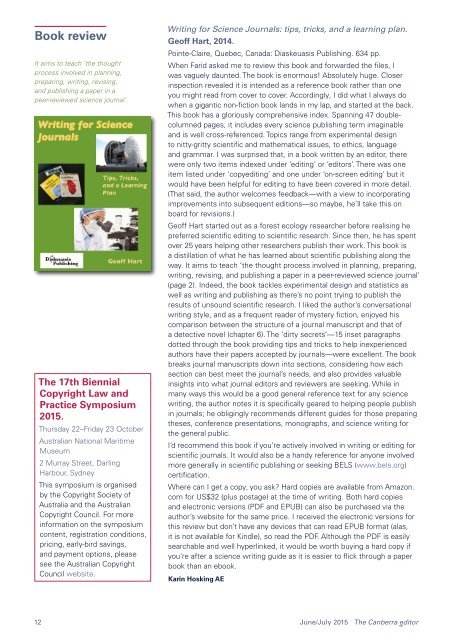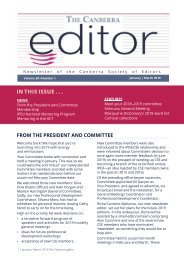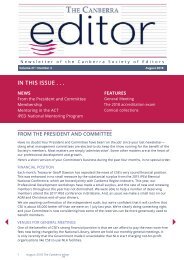The Canberra editor June-July 2015
Newsletter of the Canberra Society of Editors
Newsletter of the Canberra Society of Editors
Create successful ePaper yourself
Turn your PDF publications into a flip-book with our unique Google optimized e-Paper software.
Book review<br />
It aims to teach ‘the thought<br />
process involved in planning,<br />
preparing, writing, revising,<br />
and publishing a paper in a<br />
peer-reviewed science journal’.<br />
<strong>The</strong> 17th Biennial<br />
Copyright Law and<br />
Practice Symposium<br />
<strong>2015</strong>.<br />
Thursday 22–Friday 23 October<br />
Australian National Maritime<br />
Museum<br />
2 Murray Street, Darling<br />
Harbour, Sydney<br />
This symposium is organised<br />
by the Copyright Society of<br />
Australia and the Australian<br />
Copyright Council. For more<br />
information on the symposium<br />
content, registration conditions,<br />
pricing, early-bird savings,<br />
and payment options, please<br />
see the Australian Copyright<br />
Council website.<br />
Writing for Science Journals: tips, tricks, and a learning plan.<br />
Geoff Hart, 2014.<br />
Pointe-Claire, Quebec, Canada: Diaskeuasis Publishing. 634 pp.<br />
When Farid asked me to review this book and forwarded the files, I<br />
was vaguely daunted. <strong>The</strong> book is enormous! Absolutely huge. Closer<br />
inspection revealed it is intended as a reference book rather than one<br />
you might read from cover to cover. Accordingly, I did what I always do<br />
when a gigantic non-fiction book lands in my lap, and started at the back.<br />
This book has a gloriously comprehensive index. Spanning 47 doublecolumned<br />
pages, it includes every science publishing term imaginable<br />
and is well cross-referenced. Topics range from experimental design<br />
to nitty-gritty scientific and mathematical issues, to ethics, language<br />
and grammar. I was surprised that, in a book written by an <strong>editor</strong>, there<br />
were only two items indexed under ‘editing’ or ‘<strong>editor</strong>s’. <strong>The</strong>re was one<br />
item listed under ‘copyediting’ and one under ‘on-screen editing’ but it<br />
would have been helpful for editing to have been covered in more detail.<br />
(That said, the author welcomes feedback—with a view to incorporating<br />
improvements into subsequent editions—so maybe, he’ll take this on<br />
board for revisions.)<br />
Geoff Hart started out as a forest ecology researcher before realising he<br />
preferred scientific editing to scientific research. Since then, he has spent<br />
over 25 years helping other researchers publish their work. This book is<br />
a distillation of what he has learned about scientific publishing along the<br />
way. It aims to teach ‘the thought process involved in planning, preparing,<br />
writing, revising, and publishing a paper in a peer-reviewed science journal’<br />
(page 2). Indeed, the book tackles experimental design and statistics as<br />
well as writing and publishing as there’s no point trying to publish the<br />
results of unsound scientific research. I liked the author’s conversational<br />
writing style, and as a frequent reader of mystery fiction, enjoyed his<br />
comparison between the structure of a journal manuscript and that of<br />
a detective novel (chapter 6). <strong>The</strong> ‘dirty secrets’—15 inset paragraphs<br />
dotted through the book providing tips and tricks to help inexperienced<br />
authors have their papers accepted by journals—were excellent. <strong>The</strong> book<br />
breaks journal manuscripts down into sections, considering how each<br />
section can best meet the journal’s needs, and also provides valuable<br />
insights into what journal <strong>editor</strong>s and reviewers are seeking. While in<br />
many ways this would be a good general reference text for any science<br />
writing, the author notes it is specifically geared to helping people publish<br />
in journals; he obligingly recommends different guides for those preparing<br />
theses, conference presentations, monographs, and science writing for<br />
the general public.<br />
I’d recommend this book if you’re actively involved in writing or editing for<br />
scientific journals. It would also be a handy reference for anyone involved<br />
more generally in scientific publishing or seeking BELS (www.bels.org)<br />
certification.<br />
Where can I get a copy, you ask? Hard copies are available from Amazon.<br />
com for US$32 (plus postage) at the time of writing. Both hard copies<br />
and electronic versions (PDF and EPUB) can also be purchased via the<br />
author’s website for the same price. I received the electronic versions for<br />
this review but don’t have any devices that can read EPUB format (alas,<br />
it is not available for Kindle), so read the PDF. Although the PDF is easily<br />
searchable and well hyperlinked, it would be worth buying a hard copy if<br />
you’re after a science writing guide as it is easier to flick through a paper<br />
book than an ebook.<br />
Karin Hosking AE<br />
12 <strong>June</strong>/<strong>July</strong> <strong>2015</strong> <strong>The</strong> <strong>Canberra</strong> <strong>editor</strong>

















